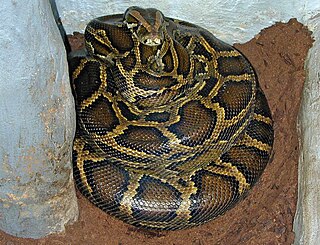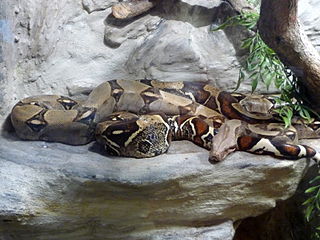Related Research Articles

The Pythonidae, commonly known as pythons, are a family of nonvenomous snakes found in Africa, Asia, and Australia. Among its members are some of the largest snakes in the world. Ten genera and 39 species are currently recognized. Being naturally non-venomous, pythons must constrict their prey to suffocate it prior to consumption. Pythons will typically strike at and bite their prey of choice to gain hold of it; they then must use physical strength to constrict their prey, by coiling their muscular bodies around the animal, effectively suffocating it before swallowing whole. This is in stark contrast to venomous snakes such as the rattlesnake, for example, which delivers a swift, venomous bite but releases, waiting as the prey succumbs to envenomation before being consumed. Collectively, the pythons are well-documented and -studied as constrictors, much like other non-venomous snakes, including the boas and even kingsnakes of the New World.

Snakes are elongated, limbless, carnivorous reptiles of the suborder Serpentes. Like all other squamates, snakes are ectothermic, amniote vertebrates covered in overlapping scales. Many species of snakes have skulls with several more joints than their lizard ancestors, enabling them to swallow prey much larger than their heads. To accommodate their narrow bodies, snakes' paired organs appear one in front of the other instead of side by side, and most have only one functional lung. Some species retain a pelvic girdle with a pair of vestigial claws on either side of the cloaca. Lizards have independently evolved elongate bodies without limbs or with greatly reduced limbs at least twenty-five times via convergent evolution, leading to many lineages of legless lizards. These resemble snakes, but several common groups of legless lizards have eyelids and external ears, which snakes lack, although this rule is not universal.

The reticulated python is a python species native to South and Southeast Asia. It is the world's longest snake, and the third heaviest after the green anaconda and Burmese python. It is listed as least concern on the IUCN Red List because of its wide distribution. In several countries in its range, it is hunted for its skin, for use in traditional medicine, and for sale as pets. Due to this, reticulated pythons are one of the most economically important reptiles worldwide.

Python is a 2000 made-for-TV horror film directed by Richard Clabaugh. The film features several cult favorite actors, including William Zabka of The Karate Kid fame, Wil Wheaton, Casper Van Dien, Jenny McCarthy, Keith Coogan, Robert Englund, Dana Barron, David Bowe, and Sean Whalen.

The Burmese python is one of the largest species of snakes. It is native to a large area of Southeast Asia and is listed as Vulnerable on the IUCN Red List. Until 2009, it was considered a subspecies of the Indian python, but is now recognized as a distinct species. It is an invasive species in Florida as a result of the pet trade.

The green tree python, also known as the emerald green python, is a species of snake in the family Pythonidae. The species is native to New Guinea, some islands in Indonesia, and the Cape York Peninsula in Australia. First described by Hermann Schlegel in 1872, it was known for many years as Chondropython viridis. As its common name suggests, it is a bright green snake that can reach a total length of 2 m (6.6 ft) and a weight of 1.6 kg (3.5 lb), with females slightly larger and heavier than males. Living generally in trees, the green tree python mainly hunts and eats small reptiles and mammals. It is a popular pet, and numbers in the wild have suffered with large-scale smuggling of wild-caught green tree pythons in Indonesia. Despite this, the green tree python is rated as least concern on the IUCN Red List of endangered species.

The green anaconda, also known as the giant anaconda, emerald anaconda, common anaconda, common water boa, or southern green anaconda, is a boa species found in South America and the Caribbean island of Trinidad. It is the largest, heaviest and the second longest snake in the world, after the reticulated python. No subspecies are currently recognized. Like all boas, it is a non-venomous constrictor.

The Central African rock python is a species of large constrictor snake in the family Pythonidae. The species is native to sub-Saharan Africa. It is one of 10 living species in the genus Python.

Thamnophis saurita saurita, the eastern ribbon snake or common ribbon snake, is one of four subspecies of the ribbon snake found in the southeastern United States.

The Timor python is a python species found in Southeast Asia. A dwarf species, no subspecies are recognized as being valid. Like all pythons, it is a nonvenomous constrictor; unlike larger species such as the reticulated python, it is not considered dangerous to humans.
A man-eater is an individual animal or being that preys on humans as a pattern of hunting behavior. This does not include the scavenging of corpses, a single attack born of opportunity or desperate hunger, or the incidental eating of a human that the animal has killed in self-defense. However, all three cases may habituate an animal to eating human flesh or to attacking humans, and may foster the development of man-eating behavior.
The blackish blind snake is a species of snake in the Typhlopidae family native to south-eastern Australia.

The boa constrictor, also known as the common boa, is a species of large, non-venomous, heavy-bodied snake that is frequently kept and bred in captivity. The boa constrictor is a member of the family Boidae. The species is native to tropical South America. A staple of private collections and public displays, its color pattern is highly variable yet distinctive. Four subspecies are recognized.
Akbar is both a given name and a surname. Notable people with the name include:

Eating live animals is the practice of humans eating animals that are still alive. It is a traditional practice in many East Asian food cultures. Animals may also be eaten alive for shock value. Eating live animals, or parts of live animals, may be unlawful in certain jurisdictions under animal cruelty laws. Religious prohibitions on the eating of live animals by humans are also present in various world religions.

Slither.io is a multiplayer online video game available for iOS, Android, and web browsers, developed by Steve Howse. Players control an avatar resembling a snake, which consumes multi-colored pellets, both from other players and ones that naturally spawn on the map in the game, to grow in size. The objective of the game is to grow the longest snake in the server. Slither.io is similar in concept to the popular 2015 web game Agar.io and is reminiscent of the classic arcade game Snake.

The Australian scrub python, or simply scrub python is a species of snake in the family Pythonidae. The species is indigenous to forests of northern Australia. It is one of the world's longest and largest snakes, and is the longest and largest in Australia. Recently, it has been reclassified to the genus Simalia alongside a few other former Morelia species, but scientific debate over this continues.
Champavati is an Assamese folk tale. It was first collected in the compilation of Assamese folklore titled Burhi Aair Sadhu, by poet Lakshminath Bezbaroa. According to scholar Praphulladatta Goswami, the tale is "current in North Lakhimpur".
The Story of the Hamadryad is a folktale from the Arakanese people, collected by researcher San Shwe Bu and published in the Journal of the Burma Research Society.
References
- ↑ Kelly, Sean (March 30, 2017). "Man Cut Out Of Massive Python (Video)". America Now. Archived from the original on September 10, 2017. Retrieved January 28, 2021.
- ↑ Koulouris, Christopher. "Photos: Akbar Salubiro Indonesian man eaten alive by python found. - Scallywag and Vagabond". scallywagandvagabond.com. Retrieved May 28, 2017.
- ↑ "Missing man killed, swallowed whole by python". Toronto Sun. Associated Press. Retrieved May 28, 2017.
- ↑ Ross, Eleanor (March 29, 2017). "Python Eats Man Whole in Indonesia". Archived from the original on March 29, 2017. Retrieved May 28, 2017.
- ↑ "Indonesian Man Eaten By Python, Cut From Stomach (VIDEO) | eCanadaNow". www.ecanadanow.com. Retrieved May 28, 2017.
- ↑ "Indonesian man's body found inside python - police". BBC News. March 29, 2017. Retrieved May 28, 2017.
- ↑ Arp, Kelsey (August 6, 2019). "We've Degraded Snakes' Habitats So They've Found Something New to Eat: Us". Slate Magazine. Retrieved October 2, 2019.
- ↑ Nurhadi (March 28, 2017). "Beginilah Ular Piton Menelan Akbar Petani Sawit Memuju Tengah". Tribun Timur (in Indonesian). Retrieved March 28, 2017.
- ↑ "Missing man found dead in belly of 7m-long python in Indonesia: Report". Straits Times. March 29, 2017. Retrieved March 29, 2017.
- ↑ "Indonesian man's body found inside python – police". BBC. March 29, 2017. Retrieved March 29, 2017.
- ↑ Inertia, The. "23-Foot Python Eats Indonesian Man on the Island of Sulawesi". The Inertia. Retrieved May 28, 2017.
- ↑ "7-meter-long python swallows Indonesian woman". National Post. June 16, 2018. Retrieved June 16, 2018.
- ↑ Geggel, Laura (June 19, 2018). "How a Python Ate a Woman Whole and Left Hardly a Trace of the Fierce Attack". livescience.com. Retrieved October 2, 2019.
- ↑ Alund, Natalie Neysa. "Missing grandmother eaten alive by 22-foot-long python in Indonesia, officials say". USA TODAY. Retrieved December 5, 2023.
- ↑ Brown, Lee (October 25, 2022). "Missing grandma's body found inside monster python". New York Post. Retrieved April 15, 2023.